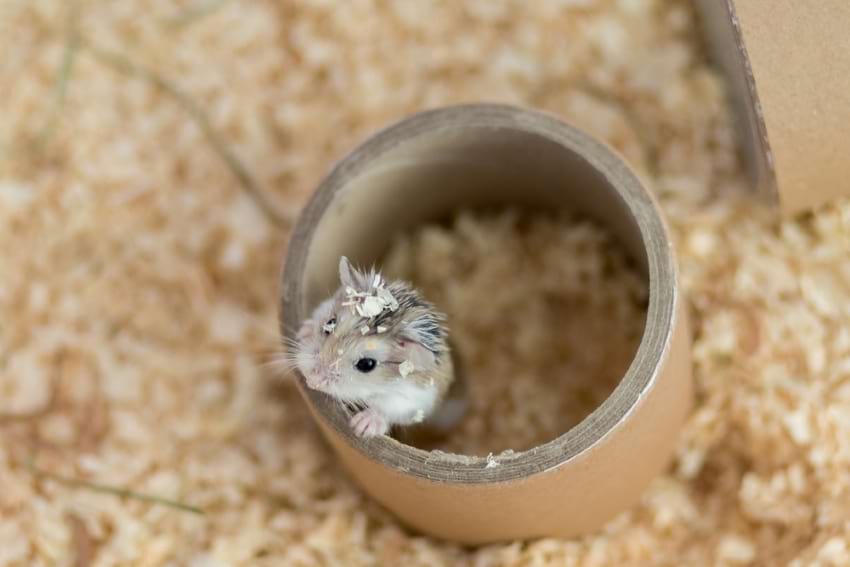Essential Care Guide for Beginners

Roborovski dwarf hamsters, also known as Robo hamsters or desert hamsters, are the smallest species in the Phodopus genus, making them an adorable and popular choice as pets. Originating from the deserts of Central Asia, these tiny creatures are known for their incredible speed and curious nature. Although they may be timid at times, most Roborovski hamsters can be tamed with time and patience.
When it comes to caring for a Roborovski dwarf hamster, you’ll need to learn about their specific needs to keep them happy and healthy. From proper housing and diet to exercise and enrichment, these small creatures require careful attention.
With this guide, you should be able to get a solid understanding of Robo’s unique needs and provide an ideal environment for your hamster to thrive. So, let’s get started!
Where Do Roborovski Dwarf Hamsters Come From
Roborovski hamsters are native to the deserts of Central Asia, including Mongolia, China, and Russia. These hamsters are primarily found in the semi-arid regions of the Gobi Desert, where they have adapted to living in extreme environments with limited access to water. This is why they don’t produce a lot of urine – lucky for us!

Roborovski hamsters are named after the Russian explorer Vsevolod Roborovski, who discovered them in 1894 during his travels across Asia. They were first introduced to the Western world in the 1960s, and since then, they have become a popular pet choice due to their cute and playful nature.
In their natural habitat, Roborovski hamsters are burrowing animals that live in complex underground tunnels. They are most active at night and in the early morning when temperatures are cooler, and they’re less visible to predators.
Knowing where Roborovski hamsters come from helps us create a more suitable and comfortable environment for these tiny pets when we bring them home. Since they live in desert areas, it’s essential to provide enough sandy areas in their cage to mimic their natural environment.
Size
As a new Roborovski hamster owner, you’ll notice that these small creatures are indeed tiny in size. Your Robo hamster will typically reach an adult length of around 2 inches (5 centimeters) and weigh between 20 to 30 grams (0.7-1 ounce) when fully grown. This makes them the smallest among the three hamster species in the Phodopus genus.
It’s important to know that Roborovski hamsters can easily squeeze into tight spaces and escape enclosures with larger bar spacing due to their small size. If you use a barred cage for your hamster, ensure the bar spacing isn’t wider than ¼ inch (0.6 cm) to prevent escapes.
Colors & Appearance
Roborovski hamsters come in a variety of colors, including white, brown, gray, and sandy brown. The original wild type “agouti” Roborovski hamster has a white belly, sandy brown coat, and gray hair roots.
Robo’s eyes are black and beady, which gives them a cute and innocent look. They can also have red eyes but it is not very common.
One of the most striking features of Roborovski hamsters is their distinctive mask-like markings around their eyes. These markings are usually darker and give the hamsters a unique appearance.
Roborovski hamsters also have a strong sense of smell, which is why they have scent glands on their belly. These glands produce a distinctive scent that helps them mark their territory and communicate with other hamsters.
Roborovski Dwarf Hamster Lifespan
Similarly to all pet hamster species, Roborovski hamsters typically have a lifespan of 2 to 3 years in captivity. However, some may live up to 4 years with the proper care! In the wild, Roborovski hamsters have a shorter lifespan of around 1-1.5 years.
Genetics is one of the main factors impacting your Robo hamster’s lifespan. Additionally, their living conditions and diet play a significant role in determining their health and longevity. By providing them with a safe, enriching environment and a well-balanced diet, you can increase their chances of living a longer, happier life.
Monitor your hamster’s overall health, and if you notice any changes or signs of illness, consult a veterinarian. Prompt treatment of any medical issues can prolong your hamster’s life.
Habitat and Housing

As mentioned, wild Roborovski hamsters live in semi-deserts, steppes, and grasslands with loose soil that allows them to dig burrows. Creating a similar environment is essential to keep our pets comfortable and healthy. Here are a few crucial aspects to consider when setting up your Robo’s habitat.
Minimum Cage Size
For housing your Roborovski hamster, ensure that the cage is at least 775 sq. in. (5000 cm²), equating to 100 x 50 cm (39 x 20 in) of floor size. Research has shown that hamsters exhibit significantly more stress-induced behavior when housed in small cages, and that’s why animal welfare organizations set these minimum cage size requirements.
A larger enclosure is always better, providing more space for your hamster to explore, exercise, and forage.
Setting Up a Cage
There are different types of cages to choose from for your hamster, including glass cages, aquariums and wire cages. Each has its own advantages and disadvantages:
- Glass cages or aquarium: These enclosures provide better visibility and prevent bedding from spilling out. They also come in large footprints, providing hamsters ample room to run. The disadvantage is that they can be expensive.
- Wire cage: Wire cages offer better ventilation and are usually lighter, making them easier to move. However, most wire cages you can buy in a pet shop don’t have the necessary floor space to meet the minimum size requirements. Most also don’t have a deep enough base to fit 8 inches of bedding for burrowing. Wire cages are less secure if the bars are not spaced closely enough.
We’ve listed some of the best hamster cages on the market if you need some help in that department.
When setting up the cage, ensure that you provide the following supplies:
- Bedding: Roborovski hamsters thrive with 8-10 inches of bedding, allowing them to dig and burrow to their heart’s content. Use non-dusty, soft substrate that holds burrows like paper bedding mixed with aspen shavings and hay. See more hamster bedding options here.
- Hideouts: Add a few hideouts to the cage, such as wooden houses or ceramic hides, to offer your hamster a safe, dark place to sleep and relax.
- Toys: Enrich your hamster’s environment with toys like tunnels, bridges, and wooden chews to keep them active and entertained.
- Wheel: Your hamster will need a wheel made of solid materials (no metal bars) with a minimum diameter of 8″ (20cm) or more. A wheel smaller than this can cause back injury to your hamster.
Importance of Sand in Robos’ Cage
A key feature of a Roborovski hamster’s habitat is sand. It’s recommended that ⅓ of their cage is filled with sand.
Adding a sandy area in your pet’s enclosure offers several benefits:
- Hygiene: Hamsters use sand baths to clean their fur and groom themselves by rolling around in the sand.
- Enrichment: Sandy areas replicate Robo’s natural habitat, helping reduce stress and promoting overall health and well-being.
- Digging: Providing a section with 1-2 inches of sand in the cage allows your hamster to dig, engaging in their instinctual behaviors.
Use dust-free sand to prevent respiratory issues. Avoid scented or colored sand, sand labeled “dust” or “powder”, and any sand with minerals added in. See a list of safe sand options for hamsters here.
Behavior and Temperament

Robos are nocturnal, meaning they are most active at night and sleep during the day. When awake, robos are known to be fast and agile, often running on their wheels or exploring their habitat with curiosity and enthusiasm.
They have high energy levels and love to exercise, which is why it is essential to provide them with plenty of toys and activities to keep them entertained.
While roborovski hamsters are charming and adorable pets, their temperament makes them challenging to handle. Due to their small size, quick movements, and skittish nature, they are not the best hamsters for those who want a cuddly pet that’s easy to handle and hold. For the same reason, they’re not a good choice for small children as these delicate animals can easily get hurt.
Be extra attentive when handling your Robo, as they can easily dart away from your grasp.
At the end of the day, all hamsters have unique personalities. Some Robos may be more daring and outgoing, while others could be more timid or introverted. Observing their reactions to new situations will help you to understand your hamster’s specific needs and preferences.
Should You Keep Roborovski Hamsters Together
In the wild, Roborovski hamsters can live in small family groups. However, when it comes to domesticated hamsters, it’s important to keep them separated after they reach six weeks of age.
Unlike their wild counterparts, domesticated hamsters can’t get away from each other when they feel threatened or have territorial conflicts. This often results in hamsters fighting or even killing each other, so cohabitation is not worth the risk.
In some cases, same-sex Robos raised together from a young age can coexist peacefully in the same cage with enough space, but this is best left to experienced hamster owners who know how to recognize fighting and when to separate them.
Also, never keep male and female hamsters together, as you’ll have lots of babies running around in no time.
How to Tame a Roborovski Hamster?

Taming a Roborovski hamster can be an enjoyable process, but it requires patience and consistency. Start the taming process when your hamster is young to increase the chances of success.
First, create a peaceful and stable environment for your Robo hamster. A cage with a floor space of at least 775 sq. inches is recommended. Provide a wooden house where your hamster can hide and feel comfortable. Place the cage in a quiet area to help your hamster feel secure and less stressed. Remove any disturbances in the area, such as loud noises or other pets.
Before starting to handle your hamster, spend some time observing their behavior. Watch out for signs of stress, such as excessive grooming, chewing on cage bars, or hiding. If your hamster seems stressed, give them more time to adjust to the environment.
To gain your hamster’s trust, always approach the cage calmly and avoid sudden movements. Start by offering treats from your hand, allowing your hamster to smell and nibble at the treat before taking it. This helps your hamster associate your scent with positive experiences.
Once your hamster is comfortable taking treats, you can start cupping your hands around them to allow them to hop in. Remember to be gentle and patient, as Roborovski hamsters can be skittish and may take some time to be comfortable with handling.
Gradually increase the amount of time your hamster spends in your hands during each session, never forcing them to stay. Maintain a regular handling schedule, as consistency is key to building trust. Avoid handling your hamster for extended periods, as this can stress them out.
Taming a Robo hamster may take time, but with dedication and patience, you can build a trusting relationship with your pet. Always respect their boundaries and don’t force them into uncomfortable situations.
What Do Roborovski Hamsters Eat? Diet and Feeding Guide

As a Roborovski hamster owner, it’s important to know about their diet and feeding habits. These tiny hamsters are omnivorous, which means they consume a mix of plant and animal-based foods. Providing them with a well-balanced diet will help ensure their health and happiness.
In the wild, Roborovski hamsters primarily consume plant-based materials such as seeds, herbs, and vegetables. They also feed on a variety of insects, like beetles, earwigs, and crickets. To replicate this natural diet, you should offer your hamster a combination of dry mix and fresh foods.
High-quality hamster dry mixes, which usually contain around 17% protein and around 10% fat, serve as a good base for their diet. Fortified mixes provide essential vitamins and minerals needed for their overall well-being. The hamster diet is a complex topic, so read more about what to feed dwarf hamsters here.
In addition to the dry mix, you should offer your Roborovski hamster fresh foods like dark leafy greens (e.g., kale, spinach, and collard greens) and vegetables such as cucumbers and celery. If your hamster’s dry mix doesn’t include insects, it’s vital to add them to their diet in small amounts. You can occasionally replace insects with lean meat or cooked chicken.
Keep a close eye on their dietary intake to prevent overfeeding or any nutritional imbalances. Adjust the amounts and types of food as needed, according to your hamster’s size, age, and activity level.
Common Health Issues in Robo Hamsters
Roborovski hamsters, like any other pet, can experience various health issues. As a responsible pet owner, you must be familiar with some common health problems they may face, so you can act quickly to help your hamster if necessary.
Skin Issues
One common issue faced by hamsters is problems with their skin and fur. If you notice your Roborovski hamster losing fur or having patches of missing fur, it could be due to several factors, such as poor diet, stress, mites, or ringworm.
Ensure your hamster has a balanced diet, a clean environment, and consult a veterinarian if you suspect a mite infestation.
Wet Tail
Wet tail is another serious issue that can affect hamsters. It is characterized by diarrhea and is often caused by stress or bacterial infection.
Bring your hamster to a veterinarian immediately if you notice your Roborovski hamster showing signs of a wet tail, such as lethargy, loss of appetite, and a soiled rear area.
Maintaining a clean habitat and minimizing stress can help prevent this condition.
Respiratory Issues
Respiratory infections are also common in hamsters, with symptoms like sneezing, wheezing, loss of appetite, decreased activity, and discharge from the eyes or nose.
Monitor your hamster’s behavior and appearance regularly. Do not hesitate to seek advice from a veterinarian if you notice any changes or suspect health issues. A proactive approach to your hamster’s well-being will go a long way in ensuring they lead a long, healthy life.
Do Roborovski Hamsters Hibernate?

Small rodents often enter a state called torpor when the environment doesn’t provide enough energy. Torpor is not the same as hibernation; it only lasts a few hours or days, unlike hibernation, which can last weeks and months.
Torpor is a natural response in some animals to conserve energy in colder temperatures or when the food is limited. It’s a survival tactic that allows them to reduce their metabolic rate and lower their body temperature.
According to research, Roborovski hamsters are usually able to maintain a constant body temperature, unlike other rodents. However, they might still be able to go into a shallow form of daily torpor that is mainly triggered by food scarcity. Research has shown that torpor in Robos only happens in moderately cold conditions, probably to avoid freezing in extremely low temperatures.
As a Roborovski hamster owner, you need to be able to recognize the signs of torpor and the appropriate steps to take if your hamster enters this state. During torpor, your hamster will become less active, and their breathing and heart rate will slow down.
To prevent your Roborovski hamster from experiencing torpor, maintain a stable temperature in their living space and provide enough food. Keeping the temperature above 59 degrees Fahrenheit (15 degrees Celsius) should be sufficient to prevent torpor. It’s also crucial for you to observe your hamster’s behavior and look for any signs of changes in their activity levels, as these could indicate that they are entering torpor.
If you suspect your Roborovski hamster is in torpor, you can help them by gradually warming their environment. Ensure that any temperature changes are made slowly to avoid causing undue stress to your pet. While it is possible to bring a hamster out of torpor by warming them up, it might affect their overall health and behavior.
Final Thoughts on Roborovski Dwarf Hamsters
I hope our guide helped you understand the needs of these adorable animals. From cage size and setup to diet and exercise, each aspect of their care is important to keep your pet happy and healthy.
If you’re still debating whether a hamster is the right pet for you, consider these pros and cons of keeping hamsters as pets before welcoming one to your family. Despite their small size, having a hamster is a big responsibility and a financial burden, so give it a good thought before adopting.



